Customer Satisfaction and Retention: A Hilton Loyalty Program Study
VerifiedAdded on 2023/01/23
|10
|2127
|86
Project
AI Summary
This research project investigates the influence of loyalty programs on customer satisfaction and retention within the hospitality sector, specifically focusing on Hilton Hotels. The study aims to assess the impact of Hilton's loyalty programs on customer satisfaction and retention, exploring the association between loyalty card programs and customer retention levels. The research sets out to identify the relationship between Hilton's loyalty programs and customer satisfaction, and recommends strategies to enhance customer satisfaction and retention. The methodology includes a literature review, qualitative research methods, an interpretivism research philosophy, and an inductive research approach. Data collection involves both primary and secondary sources, including questionnaires and interviews with senior Hilton managers. The research plan outlines a timeline for topic selection, literature review, data collection, analysis, and final submission. The findings are expected to provide valuable insights into the effectiveness of loyalty programs in the hospitality industry and offer actionable recommendations for Hilton to improve customer relationships.
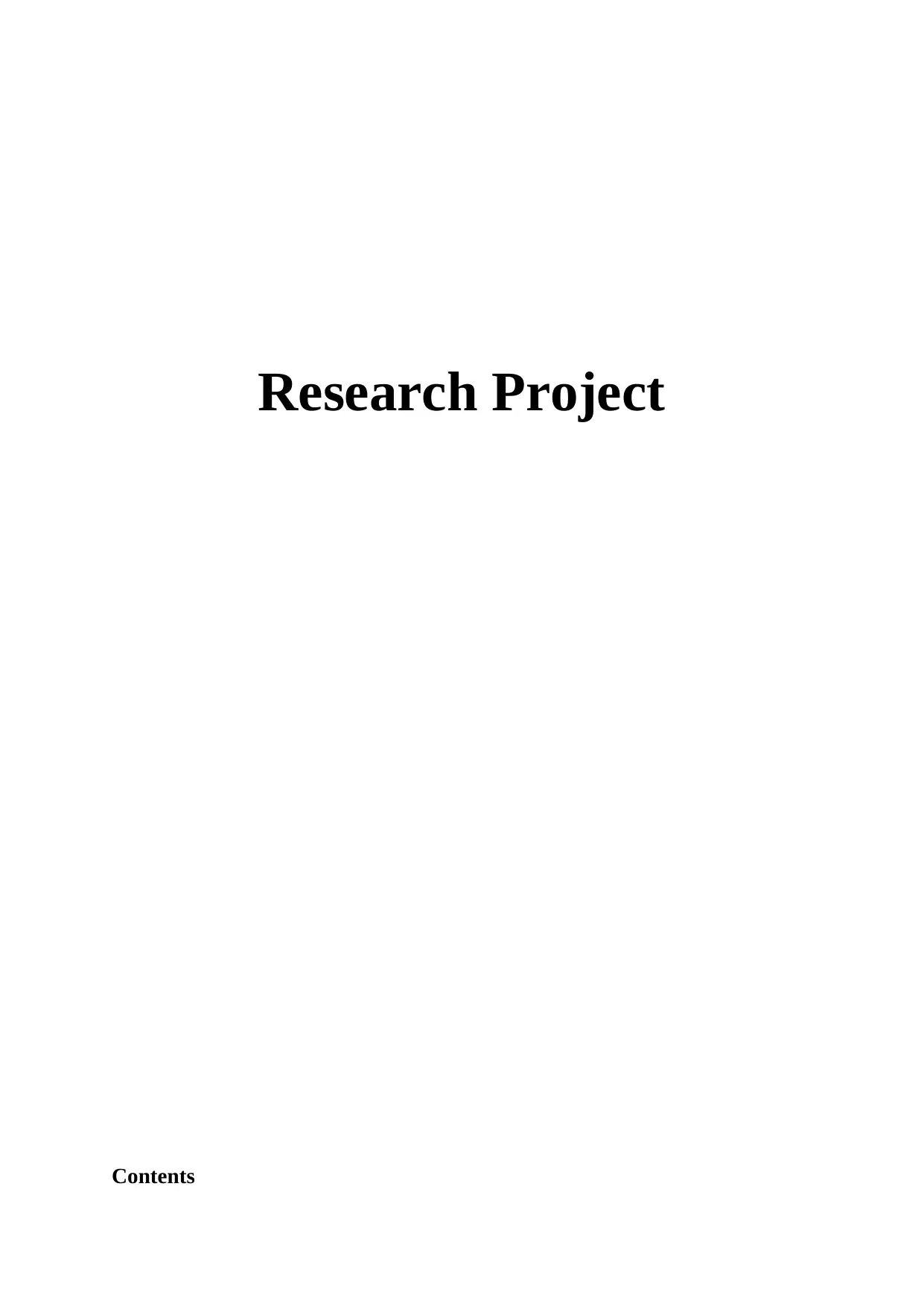
Research Project
Contents
Contents
Paraphrase This Document
Need a fresh take? Get an instant paraphrase of this document with our AI Paraphraser
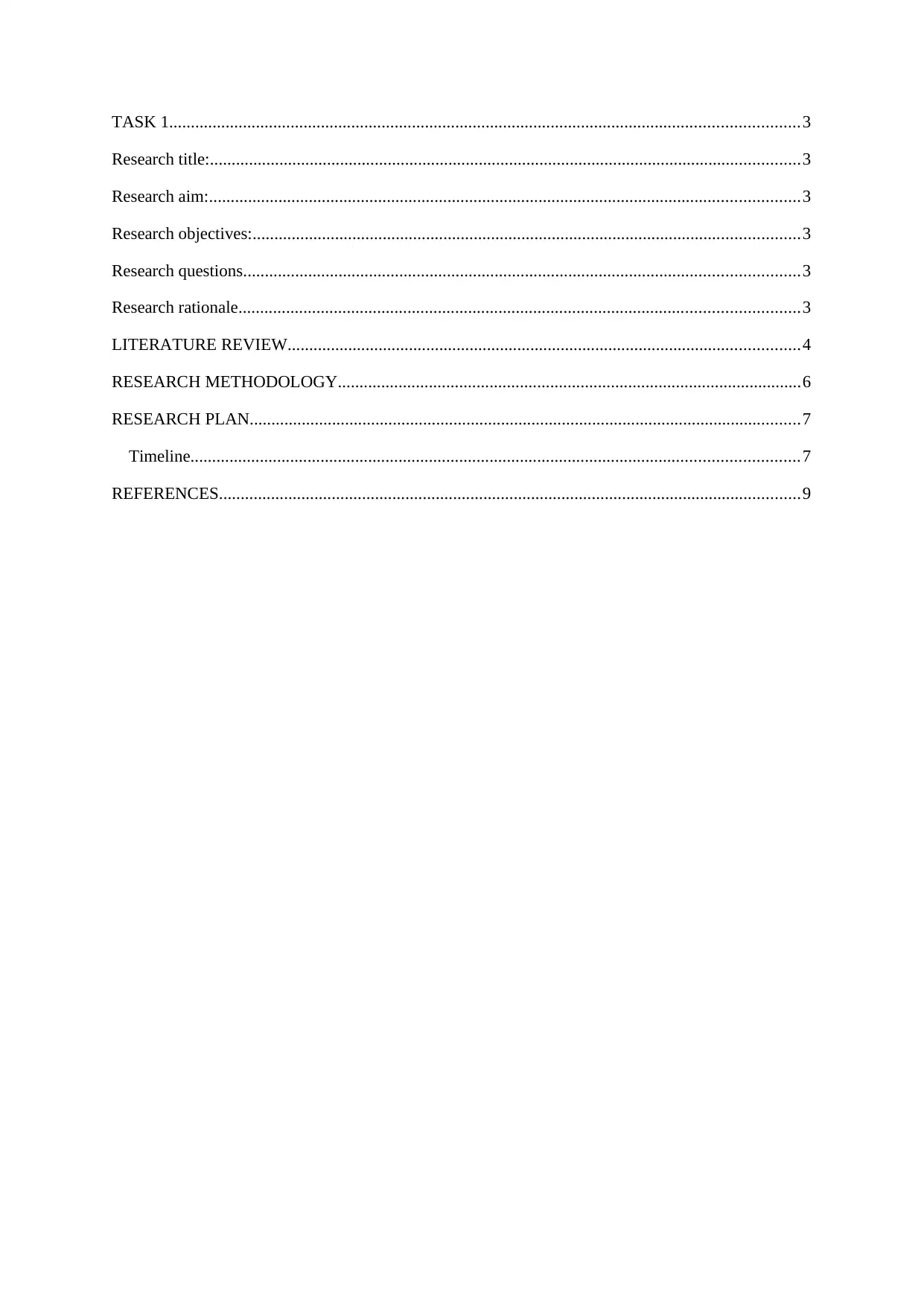
TASK 1.................................................................................................................................................3
Research title:........................................................................................................................................3
Research aim:........................................................................................................................................3
Research objectives:..............................................................................................................................3
Research questions................................................................................................................................3
Research rationale.................................................................................................................................3
LITERATURE REVIEW......................................................................................................................4
RESEARCH METHODOLOGY...........................................................................................................6
RESEARCH PLAN...............................................................................................................................7
Timeline............................................................................................................................................7
REFERENCES......................................................................................................................................9
Research title:........................................................................................................................................3
Research aim:........................................................................................................................................3
Research objectives:..............................................................................................................................3
Research questions................................................................................................................................3
Research rationale.................................................................................................................................3
LITERATURE REVIEW......................................................................................................................4
RESEARCH METHODOLOGY...........................................................................................................6
RESEARCH PLAN...............................................................................................................................7
Timeline............................................................................................................................................7
REFERENCES......................................................................................................................................9
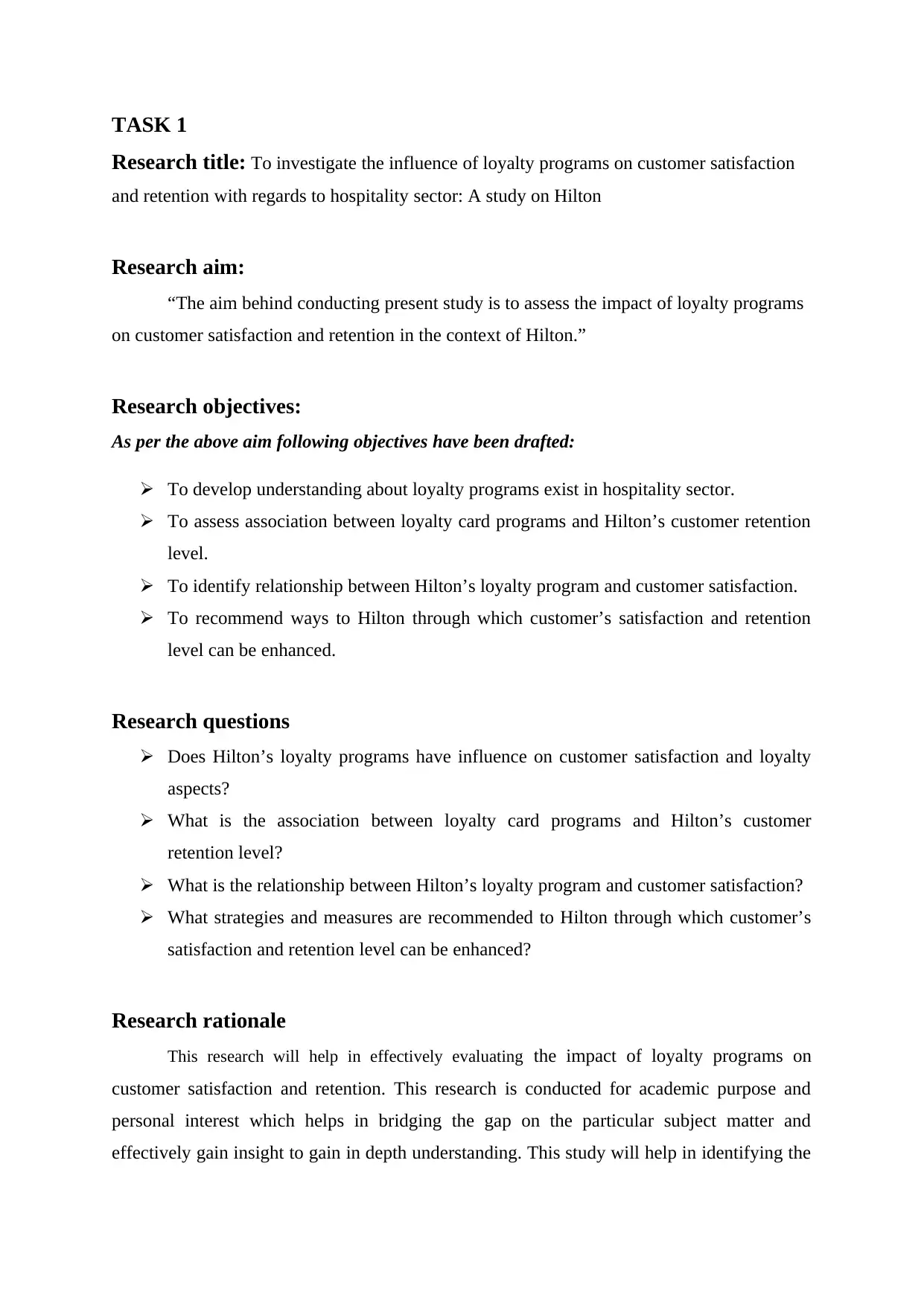
TASK 1
Research title: To investigate the influence of loyalty programs on customer satisfaction
and retention with regards to hospitality sector: A study on Hilton
Research aim:
“The aim behind conducting present study is to assess the impact of loyalty programs
on customer satisfaction and retention in the context of Hilton.”
Research objectives:
As per the above aim following objectives have been drafted:
To develop understanding about loyalty programs exist in hospitality sector.
To assess association between loyalty card programs and Hilton’s customer retention
level.
To identify relationship between Hilton’s loyalty program and customer satisfaction.
To recommend ways to Hilton through which customer’s satisfaction and retention
level can be enhanced.
Research questions
Does Hilton’s loyalty programs have influence on customer satisfaction and loyalty
aspects?
What is the association between loyalty card programs and Hilton’s customer
retention level?
What is the relationship between Hilton’s loyalty program and customer satisfaction?
What strategies and measures are recommended to Hilton through which customer’s
satisfaction and retention level can be enhanced?
Research rationale
This research will help in effectively evaluating the impact of loyalty programs on
customer satisfaction and retention. This research is conducted for academic purpose and
personal interest which helps in bridging the gap on the particular subject matter and
effectively gain insight to gain in depth understanding. This study will help in identifying the
Research title: To investigate the influence of loyalty programs on customer satisfaction
and retention with regards to hospitality sector: A study on Hilton
Research aim:
“The aim behind conducting present study is to assess the impact of loyalty programs
on customer satisfaction and retention in the context of Hilton.”
Research objectives:
As per the above aim following objectives have been drafted:
To develop understanding about loyalty programs exist in hospitality sector.
To assess association between loyalty card programs and Hilton’s customer retention
level.
To identify relationship between Hilton’s loyalty program and customer satisfaction.
To recommend ways to Hilton through which customer’s satisfaction and retention
level can be enhanced.
Research questions
Does Hilton’s loyalty programs have influence on customer satisfaction and loyalty
aspects?
What is the association between loyalty card programs and Hilton’s customer
retention level?
What is the relationship between Hilton’s loyalty program and customer satisfaction?
What strategies and measures are recommended to Hilton through which customer’s
satisfaction and retention level can be enhanced?
Research rationale
This research will help in effectively evaluating the impact of loyalty programs on
customer satisfaction and retention. This research is conducted for academic purpose and
personal interest which helps in bridging the gap on the particular subject matter and
effectively gain insight to gain in depth understanding. This study will help in identifying the
⊘ This is a preview!⊘
Do you want full access?
Subscribe today to unlock all pages.

Trusted by 1+ million students worldwide
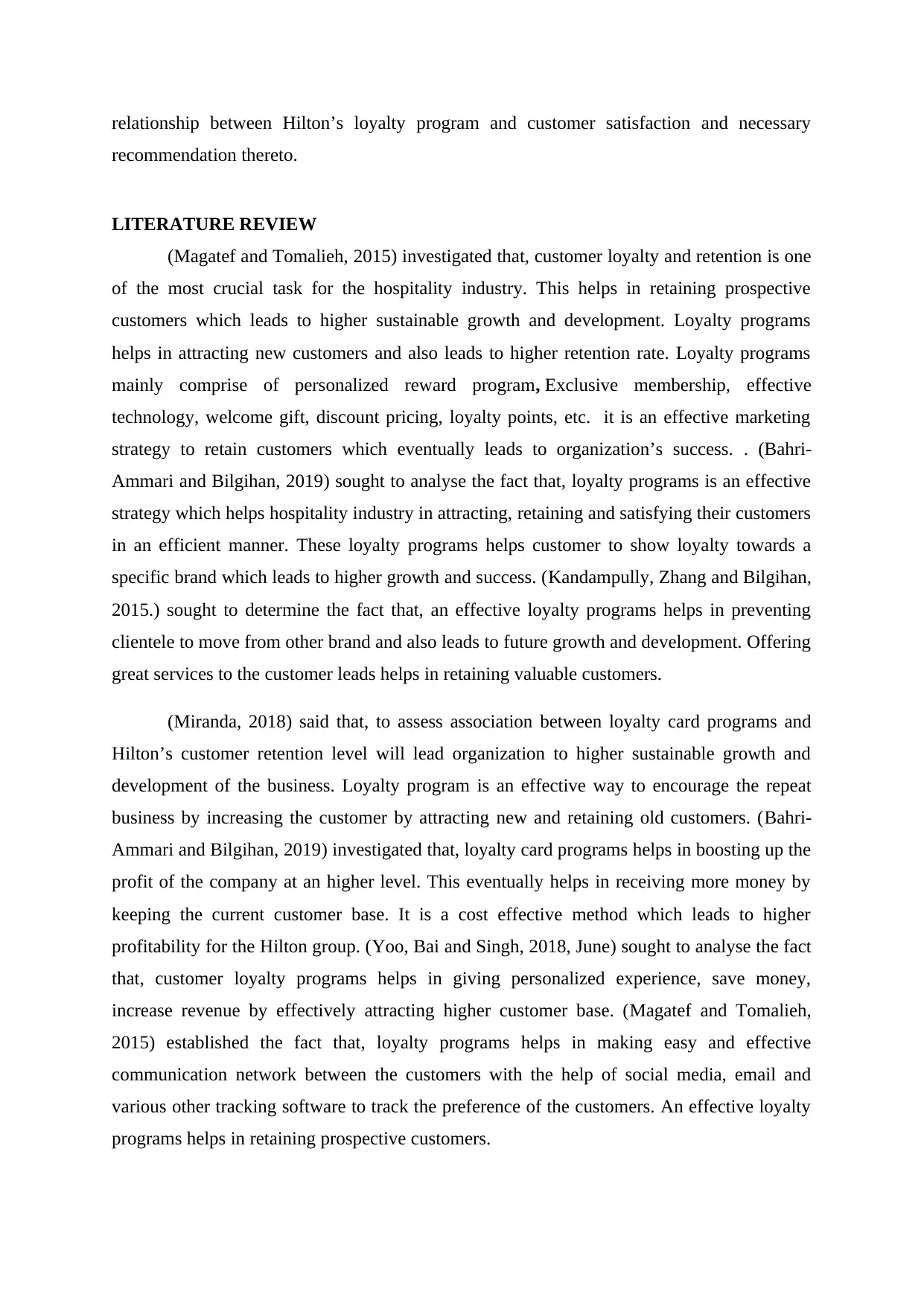
relationship between Hilton’s loyalty program and customer satisfaction and necessary
recommendation thereto.
LITERATURE REVIEW
(Magatef and Tomalieh, 2015) investigated that, customer loyalty and retention is one
of the most crucial task for the hospitality industry. This helps in retaining prospective
customers which leads to higher sustainable growth and development. Loyalty programs
helps in attracting new customers and also leads to higher retention rate. Loyalty programs
mainly comprise of personalized reward program, Exclusive membership, effective
technology, welcome gift, discount pricing, loyalty points, etc. it is an effective marketing
strategy to retain customers which eventually leads to organization’s success. . (Bahri-
Ammari and Bilgihan, 2019) sought to analyse the fact that, loyalty programs is an effective
strategy which helps hospitality industry in attracting, retaining and satisfying their customers
in an efficient manner. These loyalty programs helps customer to show loyalty towards a
specific brand which leads to higher growth and success. (Kandampully, Zhang and Bilgihan,
2015.) sought to determine the fact that, an effective loyalty programs helps in preventing
clientele to move from other brand and also leads to future growth and development. Offering
great services to the customer leads helps in retaining valuable customers.
(Miranda, 2018) said that, to assess association between loyalty card programs and
Hilton’s customer retention level will lead organization to higher sustainable growth and
development of the business. Loyalty program is an effective way to encourage the repeat
business by increasing the customer by attracting new and retaining old customers. (Bahri-
Ammari and Bilgihan, 2019) investigated that, loyalty card programs helps in boosting up the
profit of the company at an higher level. This eventually helps in receiving more money by
keeping the current customer base. It is a cost effective method which leads to higher
profitability for the Hilton group. (Yoo, Bai and Singh, 2018, June) sought to analyse the fact
that, customer loyalty programs helps in giving personalized experience, save money,
increase revenue by effectively attracting higher customer base. (Magatef and Tomalieh,
2015) established the fact that, loyalty programs helps in making easy and effective
communication network between the customers with the help of social media, email and
various other tracking software to track the preference of the customers. An effective loyalty
programs helps in retaining prospective customers.
recommendation thereto.
LITERATURE REVIEW
(Magatef and Tomalieh, 2015) investigated that, customer loyalty and retention is one
of the most crucial task for the hospitality industry. This helps in retaining prospective
customers which leads to higher sustainable growth and development. Loyalty programs
helps in attracting new customers and also leads to higher retention rate. Loyalty programs
mainly comprise of personalized reward program, Exclusive membership, effective
technology, welcome gift, discount pricing, loyalty points, etc. it is an effective marketing
strategy to retain customers which eventually leads to organization’s success. . (Bahri-
Ammari and Bilgihan, 2019) sought to analyse the fact that, loyalty programs is an effective
strategy which helps hospitality industry in attracting, retaining and satisfying their customers
in an efficient manner. These loyalty programs helps customer to show loyalty towards a
specific brand which leads to higher growth and success. (Kandampully, Zhang and Bilgihan,
2015.) sought to determine the fact that, an effective loyalty programs helps in preventing
clientele to move from other brand and also leads to future growth and development. Offering
great services to the customer leads helps in retaining valuable customers.
(Miranda, 2018) said that, to assess association between loyalty card programs and
Hilton’s customer retention level will lead organization to higher sustainable growth and
development of the business. Loyalty program is an effective way to encourage the repeat
business by increasing the customer by attracting new and retaining old customers. (Bahri-
Ammari and Bilgihan, 2019) investigated that, loyalty card programs helps in boosting up the
profit of the company at an higher level. This eventually helps in receiving more money by
keeping the current customer base. It is a cost effective method which leads to higher
profitability for the Hilton group. (Yoo, Bai and Singh, 2018, June) sought to analyse the fact
that, customer loyalty programs helps in giving personalized experience, save money,
increase revenue by effectively attracting higher customer base. (Magatef and Tomalieh,
2015) established the fact that, loyalty programs helps in making easy and effective
communication network between the customers with the help of social media, email and
various other tracking software to track the preference of the customers. An effective loyalty
programs helps in retaining prospective customers.
Paraphrase This Document
Need a fresh take? Get an instant paraphrase of this document with our AI Paraphraser
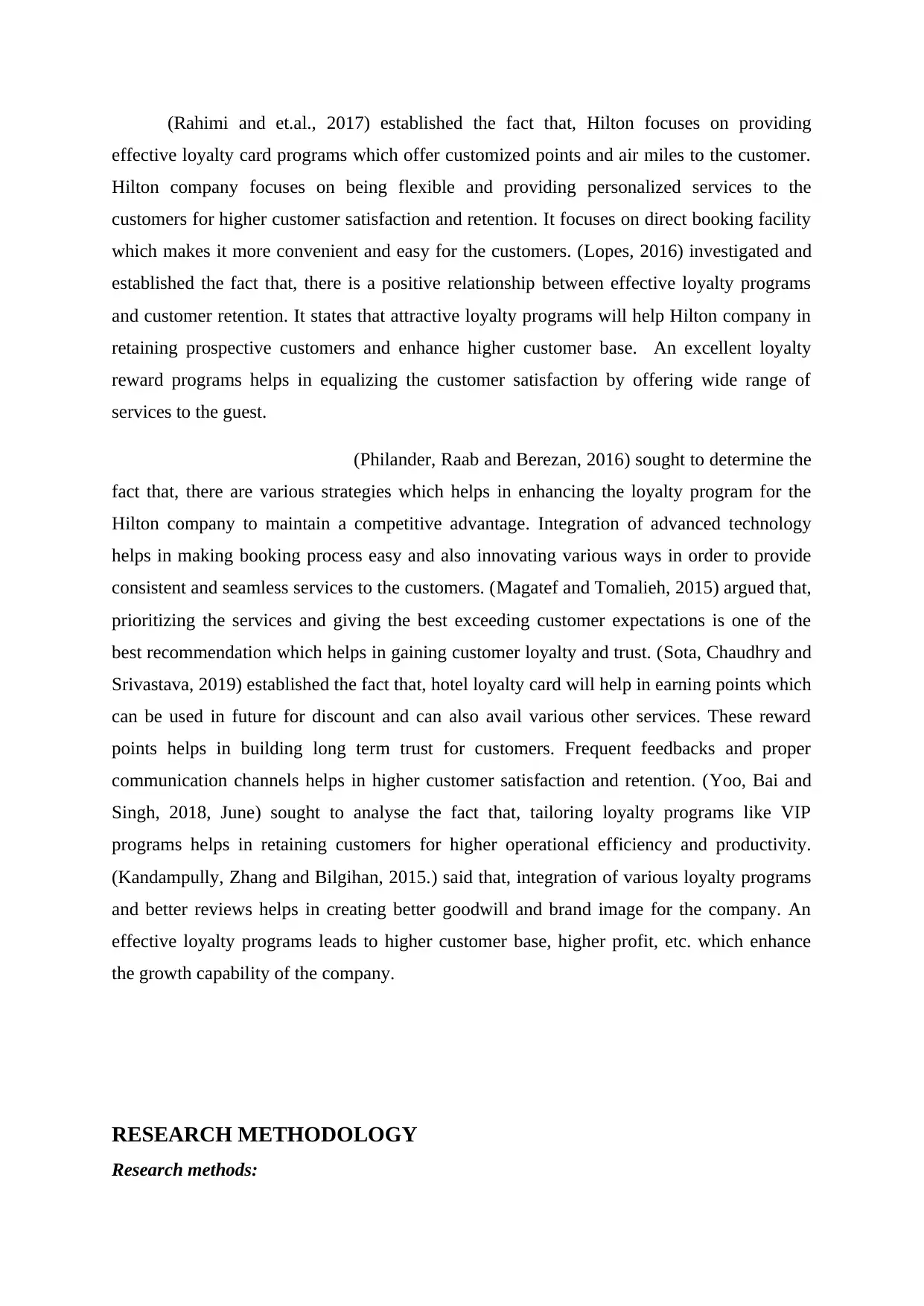
(Rahimi and et.al., 2017) established the fact that, Hilton focuses on providing
effective loyalty card programs which offer customized points and air miles to the customer.
Hilton company focuses on being flexible and providing personalized services to the
customers for higher customer satisfaction and retention. It focuses on direct booking facility
which makes it more convenient and easy for the customers. (Lopes, 2016) investigated and
established the fact that, there is a positive relationship between effective loyalty programs
and customer retention. It states that attractive loyalty programs will help Hilton company in
retaining prospective customers and enhance higher customer base. An excellent loyalty
reward programs helps in equalizing the customer satisfaction by offering wide range of
services to the guest.
(Philander, Raab and Berezan, 2016) sought to determine the
fact that, there are various strategies which helps in enhancing the loyalty program for the
Hilton company to maintain a competitive advantage. Integration of advanced technology
helps in making booking process easy and also innovating various ways in order to provide
consistent and seamless services to the customers. (Magatef and Tomalieh, 2015) argued that,
prioritizing the services and giving the best exceeding customer expectations is one of the
best recommendation which helps in gaining customer loyalty and trust. (Sota, Chaudhry and
Srivastava, 2019) established the fact that, hotel loyalty card will help in earning points which
can be used in future for discount and can also avail various other services. These reward
points helps in building long term trust for customers. Frequent feedbacks and proper
communication channels helps in higher customer satisfaction and retention. (Yoo, Bai and
Singh, 2018, June) sought to analyse the fact that, tailoring loyalty programs like VIP
programs helps in retaining customers for higher operational efficiency and productivity.
(Kandampully, Zhang and Bilgihan, 2015.) said that, integration of various loyalty programs
and better reviews helps in creating better goodwill and brand image for the company. An
effective loyalty programs leads to higher customer base, higher profit, etc. which enhance
the growth capability of the company.
RESEARCH METHODOLOGY
Research methods:
effective loyalty card programs which offer customized points and air miles to the customer.
Hilton company focuses on being flexible and providing personalized services to the
customers for higher customer satisfaction and retention. It focuses on direct booking facility
which makes it more convenient and easy for the customers. (Lopes, 2016) investigated and
established the fact that, there is a positive relationship between effective loyalty programs
and customer retention. It states that attractive loyalty programs will help Hilton company in
retaining prospective customers and enhance higher customer base. An excellent loyalty
reward programs helps in equalizing the customer satisfaction by offering wide range of
services to the guest.
(Philander, Raab and Berezan, 2016) sought to determine the
fact that, there are various strategies which helps in enhancing the loyalty program for the
Hilton company to maintain a competitive advantage. Integration of advanced technology
helps in making booking process easy and also innovating various ways in order to provide
consistent and seamless services to the customers. (Magatef and Tomalieh, 2015) argued that,
prioritizing the services and giving the best exceeding customer expectations is one of the
best recommendation which helps in gaining customer loyalty and trust. (Sota, Chaudhry and
Srivastava, 2019) established the fact that, hotel loyalty card will help in earning points which
can be used in future for discount and can also avail various other services. These reward
points helps in building long term trust for customers. Frequent feedbacks and proper
communication channels helps in higher customer satisfaction and retention. (Yoo, Bai and
Singh, 2018, June) sought to analyse the fact that, tailoring loyalty programs like VIP
programs helps in retaining customers for higher operational efficiency and productivity.
(Kandampully, Zhang and Bilgihan, 2015.) said that, integration of various loyalty programs
and better reviews helps in creating better goodwill and brand image for the company. An
effective loyalty programs leads to higher customer base, higher profit, etc. which enhance
the growth capability of the company.
RESEARCH METHODOLOGY
Research methods:
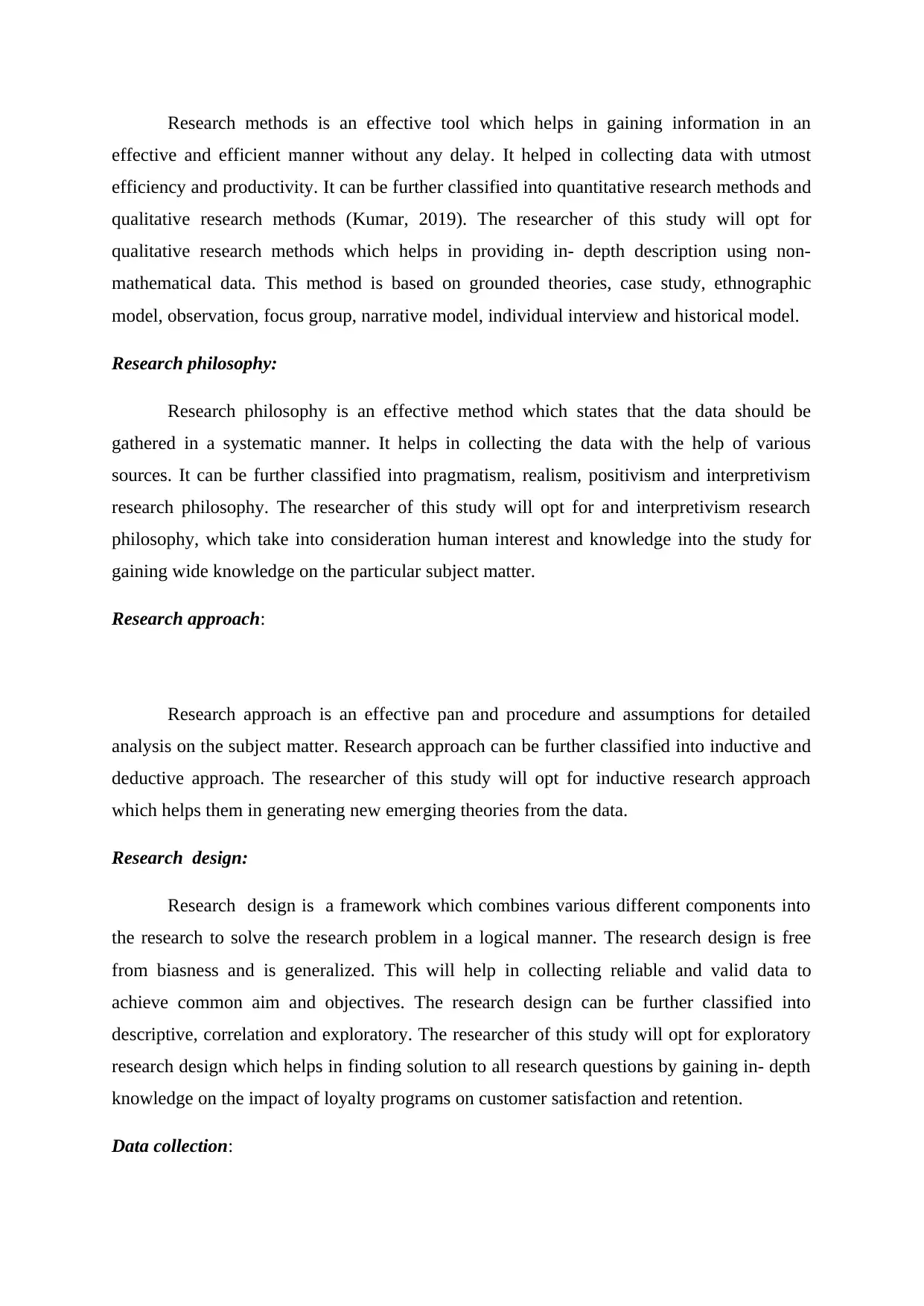
Research methods is an effective tool which helps in gaining information in an
effective and efficient manner without any delay. It helped in collecting data with utmost
efficiency and productivity. It can be further classified into quantitative research methods and
qualitative research methods (Kumar, 2019). The researcher of this study will opt for
qualitative research methods which helps in providing in- depth description using non-
mathematical data. This method is based on grounded theories, case study, ethnographic
model, observation, focus group, narrative model, individual interview and historical model.
Research philosophy:
Research philosophy is an effective method which states that the data should be
gathered in a systematic manner. It helps in collecting the data with the help of various
sources. It can be further classified into pragmatism, realism, positivism and interpretivism
research philosophy. The researcher of this study will opt for and interpretivism research
philosophy, which take into consideration human interest and knowledge into the study for
gaining wide knowledge on the particular subject matter.
Research approach:
Research approach is an effective pan and procedure and assumptions for detailed
analysis on the subject matter. Research approach can be further classified into inductive and
deductive approach. The researcher of this study will opt for inductive research approach
which helps them in generating new emerging theories from the data.
Research design:
Research design is a framework which combines various different components into
the research to solve the research problem in a logical manner. The research design is free
from biasness and is generalized. This will help in collecting reliable and valid data to
achieve common aim and objectives. The research design can be further classified into
descriptive, correlation and exploratory. The researcher of this study will opt for exploratory
research design which helps in finding solution to all research questions by gaining in- depth
knowledge on the impact of loyalty programs on customer satisfaction and retention.
Data collection:
effective and efficient manner without any delay. It helped in collecting data with utmost
efficiency and productivity. It can be further classified into quantitative research methods and
qualitative research methods (Kumar, 2019). The researcher of this study will opt for
qualitative research methods which helps in providing in- depth description using non-
mathematical data. This method is based on grounded theories, case study, ethnographic
model, observation, focus group, narrative model, individual interview and historical model.
Research philosophy:
Research philosophy is an effective method which states that the data should be
gathered in a systematic manner. It helps in collecting the data with the help of various
sources. It can be further classified into pragmatism, realism, positivism and interpretivism
research philosophy. The researcher of this study will opt for and interpretivism research
philosophy, which take into consideration human interest and knowledge into the study for
gaining wide knowledge on the particular subject matter.
Research approach:
Research approach is an effective pan and procedure and assumptions for detailed
analysis on the subject matter. Research approach can be further classified into inductive and
deductive approach. The researcher of this study will opt for inductive research approach
which helps them in generating new emerging theories from the data.
Research design:
Research design is a framework which combines various different components into
the research to solve the research problem in a logical manner. The research design is free
from biasness and is generalized. This will help in collecting reliable and valid data to
achieve common aim and objectives. The research design can be further classified into
descriptive, correlation and exploratory. The researcher of this study will opt for exploratory
research design which helps in finding solution to all research questions by gaining in- depth
knowledge on the impact of loyalty programs on customer satisfaction and retention.
Data collection:
⊘ This is a preview!⊘
Do you want full access?
Subscribe today to unlock all pages.

Trusted by 1+ million students worldwide
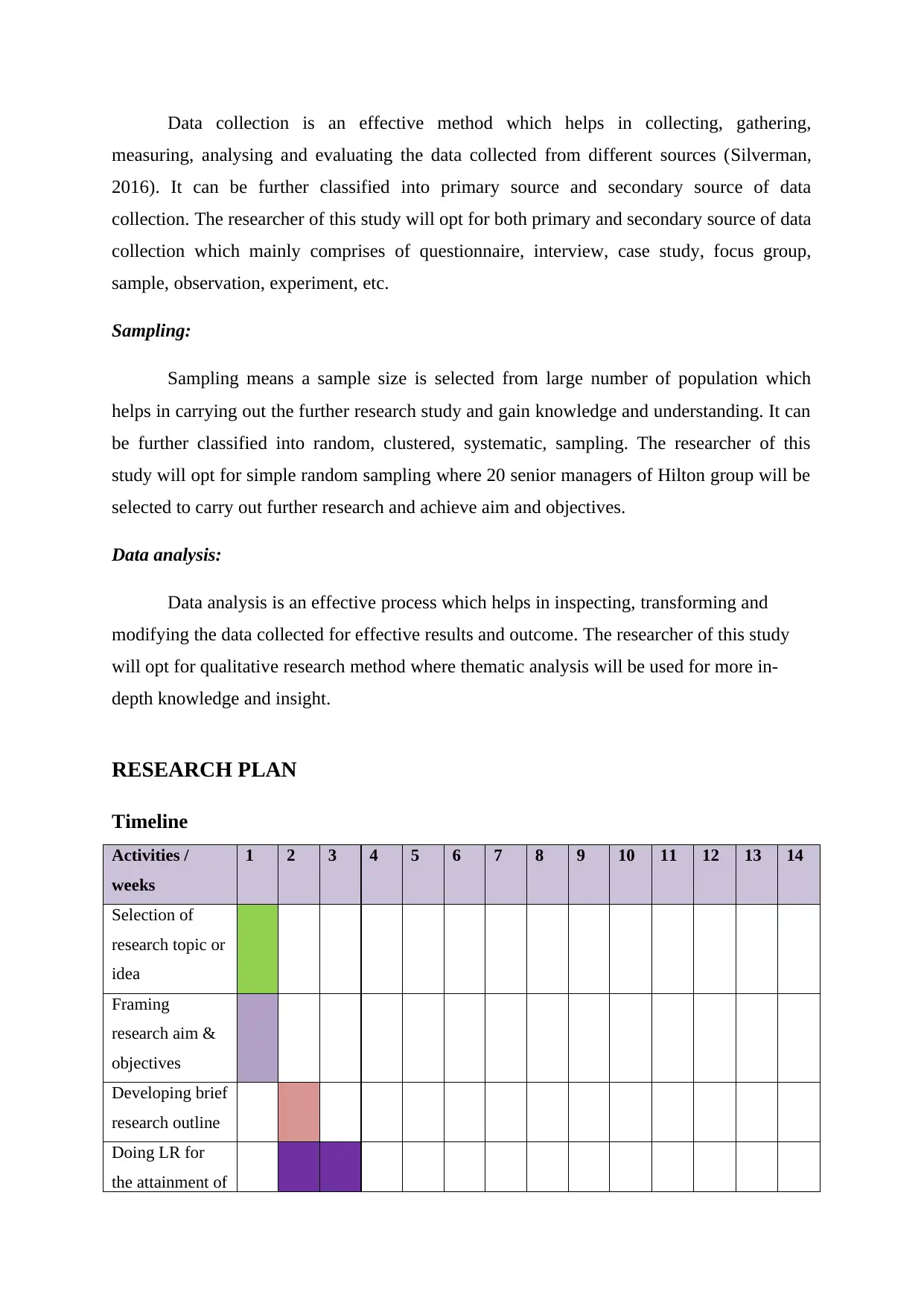
Data collection is an effective method which helps in collecting, gathering,
measuring, analysing and evaluating the data collected from different sources (Silverman,
2016). It can be further classified into primary source and secondary source of data
collection. The researcher of this study will opt for both primary and secondary source of data
collection which mainly comprises of questionnaire, interview, case study, focus group,
sample, observation, experiment, etc.
Sampling:
Sampling means a sample size is selected from large number of population which
helps in carrying out the further research study and gain knowledge and understanding. It can
be further classified into random, clustered, systematic, sampling. The researcher of this
study will opt for simple random sampling where 20 senior managers of Hilton group will be
selected to carry out further research and achieve aim and objectives.
Data analysis:
Data analysis is an effective process which helps in inspecting, transforming and
modifying the data collected for effective results and outcome. The researcher of this study
will opt for qualitative research method where thematic analysis will be used for more in-
depth knowledge and insight.
RESEARCH PLAN
Timeline
Activities /
weeks
1 2 3 4 5 6 7 8 9 10 11 12 13 14
Selection of
research topic or
idea
Framing
research aim &
objectives
Developing brief
research outline
Doing LR for
the attainment of
measuring, analysing and evaluating the data collected from different sources (Silverman,
2016). It can be further classified into primary source and secondary source of data
collection. The researcher of this study will opt for both primary and secondary source of data
collection which mainly comprises of questionnaire, interview, case study, focus group,
sample, observation, experiment, etc.
Sampling:
Sampling means a sample size is selected from large number of population which
helps in carrying out the further research study and gain knowledge and understanding. It can
be further classified into random, clustered, systematic, sampling. The researcher of this
study will opt for simple random sampling where 20 senior managers of Hilton group will be
selected to carry out further research and achieve aim and objectives.
Data analysis:
Data analysis is an effective process which helps in inspecting, transforming and
modifying the data collected for effective results and outcome. The researcher of this study
will opt for qualitative research method where thematic analysis will be used for more in-
depth knowledge and insight.
RESEARCH PLAN
Timeline
Activities /
weeks
1 2 3 4 5 6 7 8 9 10 11 12 13 14
Selection of
research topic or
idea
Framing
research aim &
objectives
Developing brief
research outline
Doing LR for
the attainment of
Paraphrase This Document
Need a fresh take? Get an instant paraphrase of this document with our AI Paraphraser
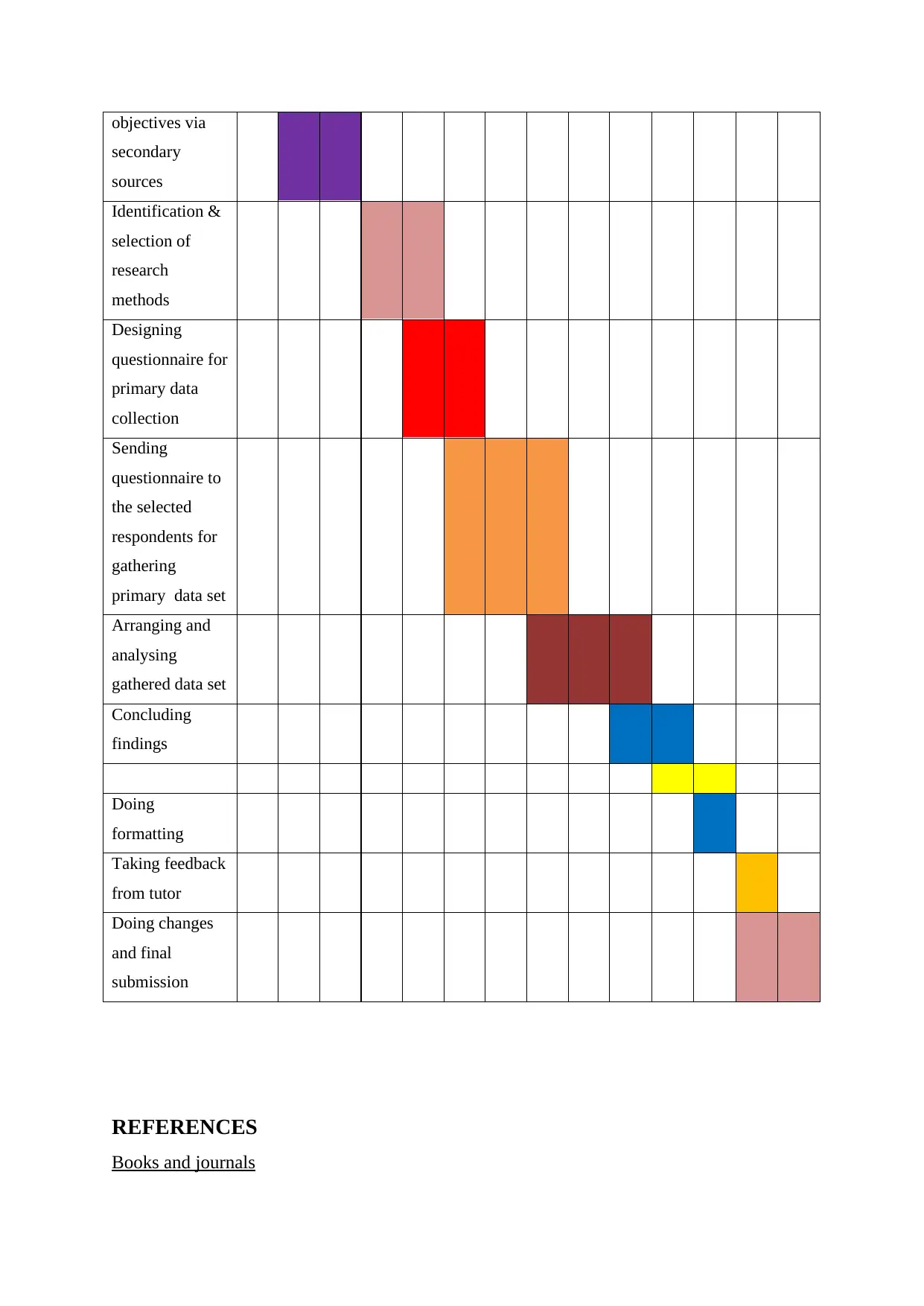
objectives via
secondary
sources
Identification &
selection of
research
methods
Designing
questionnaire for
primary data
collection
Sending
questionnaire to
the selected
respondents for
gathering
primary data set
Arranging and
analysing
gathered data set
Concluding
findings
Doing
formatting
Taking feedback
from tutor
Doing changes
and final
submission
REFERENCES
Books and journals
secondary
sources
Identification &
selection of
research
methods
Designing
questionnaire for
primary data
collection
Sending
questionnaire to
the selected
respondents for
gathering
primary data set
Arranging and
analysing
gathered data set
Concluding
findings
Doing
formatting
Taking feedback
from tutor
Doing changes
and final
submission
REFERENCES
Books and journals
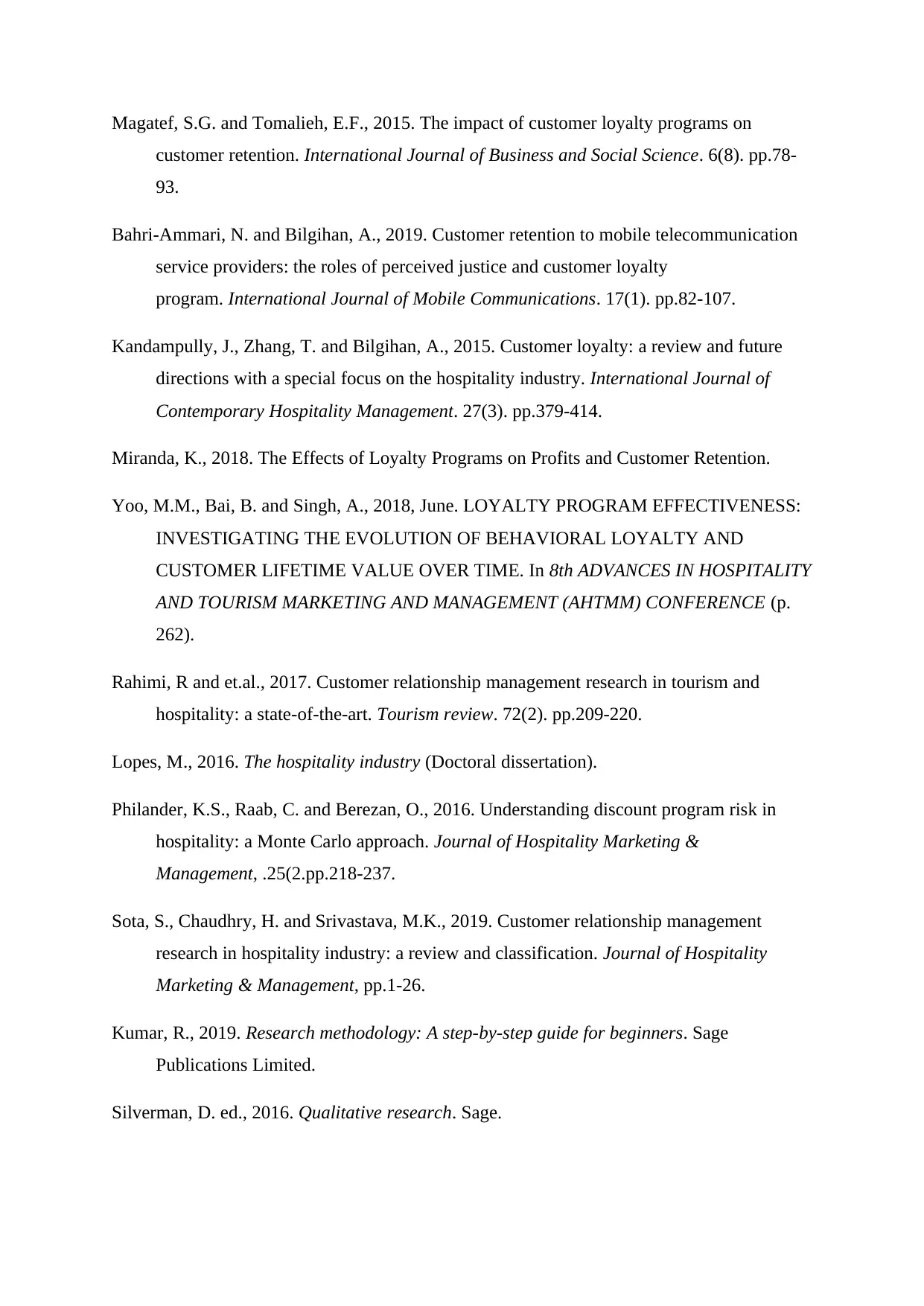
Magatef, S.G. and Tomalieh, E.F., 2015. The impact of customer loyalty programs on
customer retention. International Journal of Business and Social Science. 6(8). pp.78-
93.
Bahri-Ammari, N. and Bilgihan, A., 2019. Customer retention to mobile telecommunication
service providers: the roles of perceived justice and customer loyalty
program. International Journal of Mobile Communications. 17(1). pp.82-107.
Kandampully, J., Zhang, T. and Bilgihan, A., 2015. Customer loyalty: a review and future
directions with a special focus on the hospitality industry. International Journal of
Contemporary Hospitality Management. 27(3). pp.379-414.
Miranda, K., 2018. The Effects of Loyalty Programs on Profits and Customer Retention.
Yoo, M.M., Bai, B. and Singh, A., 2018, June. LOYALTY PROGRAM EFFECTIVENESS:
INVESTIGATING THE EVOLUTION OF BEHAVIORAL LOYALTY AND
CUSTOMER LIFETIME VALUE OVER TIME. In 8th ADVANCES IN HOSPITALITY
AND TOURISM MARKETING AND MANAGEMENT (AHTMM) CONFERENCE (p.
262).
Rahimi, R and et.al., 2017. Customer relationship management research in tourism and
hospitality: a state-of-the-art. Tourism review. 72(2). pp.209-220.
Lopes, M., 2016. The hospitality industry (Doctoral dissertation).
Philander, K.S., Raab, C. and Berezan, O., 2016. Understanding discount program risk in
hospitality: a Monte Carlo approach. Journal of Hospitality Marketing &
Management, .25(2.pp.218-237.
Sota, S., Chaudhry, H. and Srivastava, M.K., 2019. Customer relationship management
research in hospitality industry: a review and classification. Journal of Hospitality
Marketing & Management, pp.1-26.
Kumar, R., 2019. Research methodology: A step-by-step guide for beginners. Sage
Publications Limited.
Silverman, D. ed., 2016. Qualitative research. Sage.
customer retention. International Journal of Business and Social Science. 6(8). pp.78-
93.
Bahri-Ammari, N. and Bilgihan, A., 2019. Customer retention to mobile telecommunication
service providers: the roles of perceived justice and customer loyalty
program. International Journal of Mobile Communications. 17(1). pp.82-107.
Kandampully, J., Zhang, T. and Bilgihan, A., 2015. Customer loyalty: a review and future
directions with a special focus on the hospitality industry. International Journal of
Contemporary Hospitality Management. 27(3). pp.379-414.
Miranda, K., 2018. The Effects of Loyalty Programs on Profits and Customer Retention.
Yoo, M.M., Bai, B. and Singh, A., 2018, June. LOYALTY PROGRAM EFFECTIVENESS:
INVESTIGATING THE EVOLUTION OF BEHAVIORAL LOYALTY AND
CUSTOMER LIFETIME VALUE OVER TIME. In 8th ADVANCES IN HOSPITALITY
AND TOURISM MARKETING AND MANAGEMENT (AHTMM) CONFERENCE (p.
262).
Rahimi, R and et.al., 2017. Customer relationship management research in tourism and
hospitality: a state-of-the-art. Tourism review. 72(2). pp.209-220.
Lopes, M., 2016. The hospitality industry (Doctoral dissertation).
Philander, K.S., Raab, C. and Berezan, O., 2016. Understanding discount program risk in
hospitality: a Monte Carlo approach. Journal of Hospitality Marketing &
Management, .25(2.pp.218-237.
Sota, S., Chaudhry, H. and Srivastava, M.K., 2019. Customer relationship management
research in hospitality industry: a review and classification. Journal of Hospitality
Marketing & Management, pp.1-26.
Kumar, R., 2019. Research methodology: A step-by-step guide for beginners. Sage
Publications Limited.
Silverman, D. ed., 2016. Qualitative research. Sage.
⊘ This is a preview!⊘
Do you want full access?
Subscribe today to unlock all pages.

Trusted by 1+ million students worldwide

1 out of 10
Related Documents
Your All-in-One AI-Powered Toolkit for Academic Success.
+13062052269
info@desklib.com
Available 24*7 on WhatsApp / Email
![[object Object]](/_next/static/media/star-bottom.7253800d.svg)
Unlock your academic potential
Copyright © 2020–2025 A2Z Services. All Rights Reserved. Developed and managed by ZUCOL.





